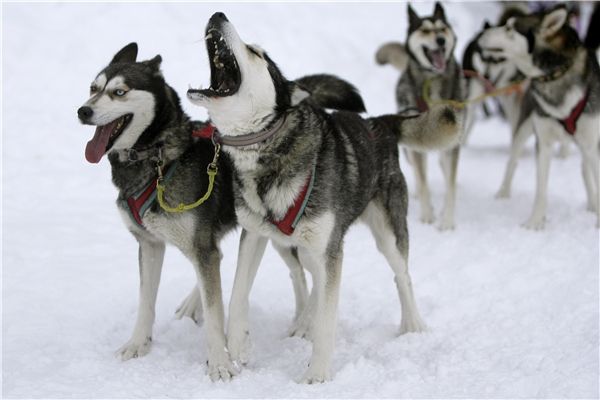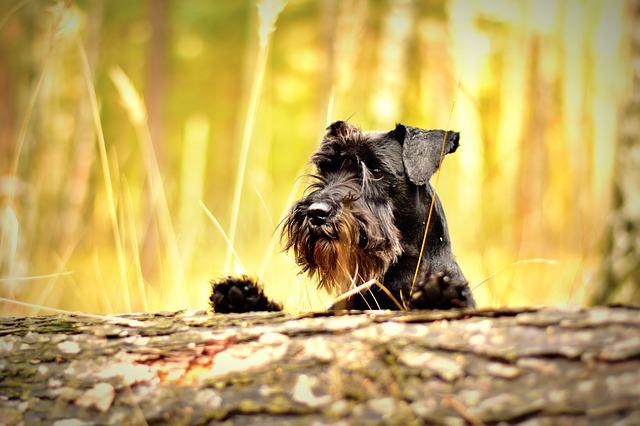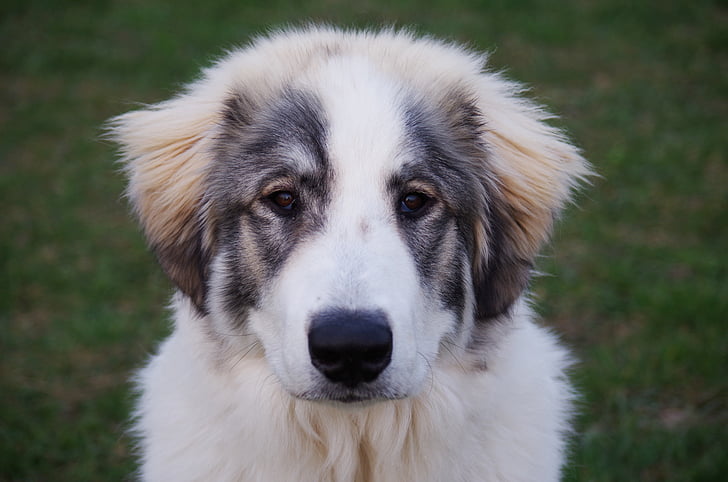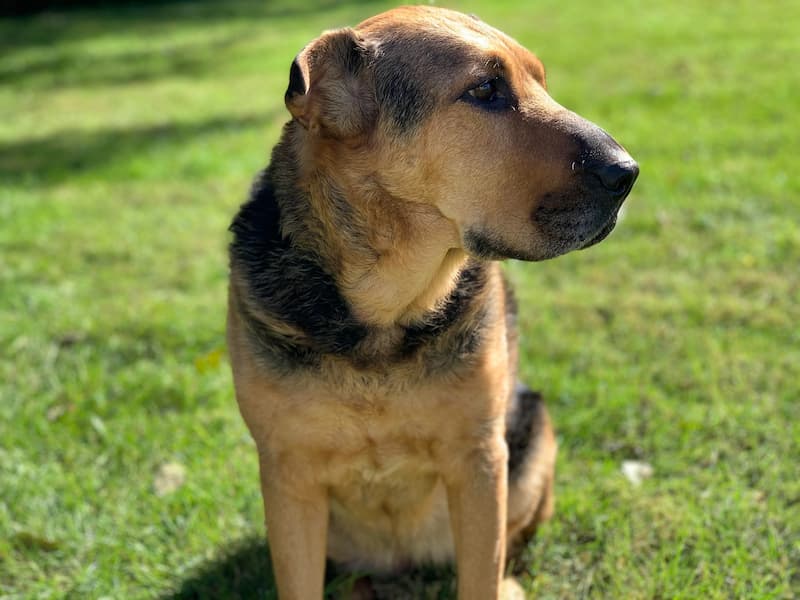
German Shar-Pei: All You Want To Know
German Shepherd Dogs and Chinese Shar-Peis are crossbred to create the German Shar-Pei, also known as the Shepherd Pei. This Shar-Pei and German Shepherd mix is a brave, self-assured, and devoted friend, but because of his watchful instincts, he might need an experienced owner to help him develop into the ideal pet as he gets older.
Make sure to do your homework and read everything there is to know about this huge bundle of love if you think this uncommon and distinctive mix is the dog for you.
Learn more by reading on.
Table of Contents
The German Shar-Pei Origin
The Designer Dog Debate
The German Shar-Pei’s history is not well known.
Mixing these breeds probably started within the past few decades with the rise of “designer dogs.”
Designated parents are chosen for desirable characteristics, setting designer dogs apart from mutts.
Designer puppies are unpredictable, and there is disagreement over whether mixed breed dogs are more healthy than purebred ones.
The fact is that both purebred and mixed-breed puppies have health risks.
According to a 2013 article in the Journal of the American Veterinary Medical Association, the presence of genetic disorders in purebred and mixed-breed animals was determined by the particular disorder, not by the breed’s purity.
No matter what you decide, do your research and pick a reputable breeder!
Shar Pei Dog Origins
The Shar Pei breed is indigenous to a small village in southern China and dates back to the Han Dynasty (200 BC).
Shar Peis were employed by farmers as guardians of their livestock, herders, and hunters. Also used as pit fighting dogs were Shar Peis.
With the founding of The People’s Republic of China in 1949 and the subsequent dog extermination, the breed’s history and almost the breed itself vanished.
Luckily, a few Shar Peis made it through this time.
By the 1970s interest in Shar Peis returned because of a campaign to save “the world’s rarest dog” by Hong Kong breeder Matgo Low
German Shepherd Origins
The German Shepherd breed was developed in Germany, as suggested by its name.
The goal of Captain Max von Stephanitz in the late 1800s was to develop the ideal herding dog. He combined different shepherd strains that were found all over Germany.
German Shepherds served in the military and as police dogs as the demand for herding dogs decreased. German Shepherds were perfect for these jobs because of their obedience and domineering personalities.
They are also employed in search and rescue operations and as guide dogs.
Appearance Of German Shar-Pei
It’s challenging to predict the appearance of Shar Pei German Shepherd puppies, as it is with most mixed-breed dog traits.
So let’s look at the parent breeds to see how they might cross.
To begin with, a Shar Pei is small and boxy. Second, it exhibits the breed-typical loose skin and deep skin wrinkles on its face and body.
Compared to adults, puppies have more wrinkles.
Thirdly, a Shar Pei has a broad muzzle and a big, flat head. The Chow Chow is the only other breed that has a tongue that is both black and blue.
A German Shepherd, however, has a lean, athletic body. It has pointy ears that are proportional to its head size and a softly angled face.
So, any of these characteristics can be exhibited by a German Shepherd and Shar Pei mix.
It will be robust and physically fit. Furthermore, although probably not as much as a Shar Pei would, it may have some loose skin and wrinkles.
These mixed-breed puppies typically resemble their Shar Pei parent by having a larger, rounder muzzle. They have either folded or pointed ears.
In conclusion, the German Shar-Pei will undoubtedly be distinctive, regardless of which parent has the most influence on the puppies.
Size Of German Shar-Pei
The Shar Pei is a medium-sized dog that is between 45 and 60 pounds in weight and 18 to 20 inches tall.
German Shepherds range in size from 50 to 90 pounds and stand 22 to 26 inches tall.
A German Shar-Pei will be fairly large if its parents are medium to large.
With a height of 26 inches and a weight of 90 pounds, it could grow as large as a male German Shepherd. Smaller dogs are more prevalent, though.
Any Shar Pei German Shepherd dog, regardless of size, will be very strong and powerful.
Shar Pei German Shepherd Color & Fur
They have a short, sandpaper-like coat, which is a defining feature of Shar Peis. “Shar Pei” translates to mean “sand-skin.”
Shar Peis come in various colors, including black, blue, brown, cream, apricot, and red. A mask, white brindle markings, tan or white cream points, and brindle markings are possible.
The double, thick coat of a German shepherd can be straight or wavy. White, sable, liver, gray, blue, and black are just a few of the 11 color combinations available.
As a result, the German Shepherd Shar Pei’s coat will be short to medium in length and won’t have the same harsh texture as the Shar Pei’s coat. Its typical color is tan, and it might have parent German Shepherd markings.
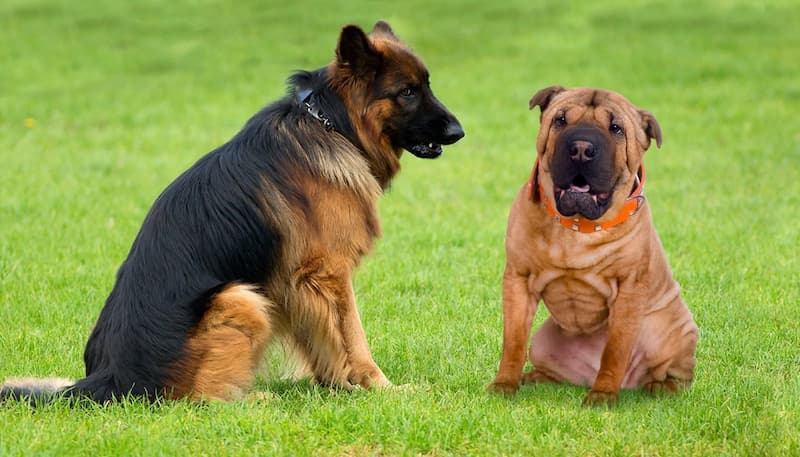
Health Of German Shar-Pei
There is not yet a lot of information available about health issues unique to Shar Pei/German Shepherd mixes.
Parents of the dogs are examined by a responsible breeder for heritable conditions. To ensure good health, you should request screening certifications when choosing a breeder.
You should be aware of the dangers posed by the breeds. The following conditions put a Shar Pei German Shepherd puppy at risk.
But keep in mind, not all dogs have health issues!
A Shar Pei German Shepherd has a better chance of living a long, healthy life if they undergo screening tests, receive the best veterinary care, exercise, and eat well.
Shar Pei Health Concerns
The Shar Pei breed is prone to a number of health problems. Some are unique to the breed:
- A hereditary inflammatory condition is Shar Pei Fever. It causes fever, swollen joints, abdomen pain, and appetite loss
- Amyloidosis is a buildup of amyloid proteins in the liver, kidney, and/or spleen which can be fatal
- Eye problems such as cherry eye, entropion, or chemosis
Skin problems such as bacterial infections in the folds, dermatitis, and demodectic mange - Hip and elbow dysplasia are the breakdown of cartilage in joints caused by abnormal development or damage
The Club recommends screening for the following:
- Hip & elbow dysplasia
- Autoimmune thyroiditis
- Patellar luxation
- Exams for eye and vision issues
German Shepherd Health Concerns
German Shepherds are generally healthy canines. However, years of selective breeding for favored physical characteristics have led to a variety of health problems.
German Shepherds are more prone to joint and spinal issues because modern breeders have focused on giving them exaggeratedly downward-sloping backs.
German Shepherds are prone to other illnesses in addition to those that are conformation-related. Here some common health issues in the breed:
- Degenerative myelopathy is a degenerative spinal cord condition that causes gradual paralysis
- Hip and elbow dysplasia
- Osteochondritis dissecans is abnormal cartilage growth in joints
- Exocrine pancreatic insufficiency is the decreased production of digestive enzymes
- Renal cystadenocarcinoma and nodular dermatofibrosis is nodule formation on the skin, usually the head and legs
- Allergies such as dermatitis, inhalant allergies, and food allergies
- Bloat
The German Shepherd Club of America recommends screening for the following:
- Hip and elbow dysplasia
- Temperament test
Temperament & Intelligence Of German Shar-Pei
Due to their combination of Shepherd-like intelligence and Shar-Pei-like independence, German Shar-Pei dogs can be difficult to train. They need a dog owner who has either experience with Chinese Shar-Pei dogs or has dealt with large dogs in the past. Though temperaments will differ greatly because German Shar-Pei dogs are typically first-generation hybrids (purebred GSD and Shar-Pei parents). The best way to get an idea is to look at the German Shepherd and the Chinese Shar-Pei temperaments:
German Shepherds are intelligent dogs with a working dog temperament who have backgrounds in guarding and herding. They are obedient dogs who enjoy working and training, but they will only obey a handler who exudes confidence and relaxation. Depending on the bloodlines and socialization, GSDs can be aggressive toward both same-sex dogs and animals. They are also affectionate dogs who enjoy playing, especially with their favorite people. German Shepherds are excellent dogs for active families with lots of space in the home, but they require hours of exercise.
The company of their families is preferred by Chinese Shar-Pei dogs, who form strong bonds and are affectionate with them. Since they were once guard dogs for royalty, they are reserved and distant around strangers and strange dogs. Because of their distinct independence and almost feline-like traits, Shar-Peis are not a good choice for novice dog owners. Although it will be on their terms, they are affectionate with their owners and enjoy spending time with them. Chinese Shar-Peis can be difficult to train because they can become reactive if they are overworked. See more about Great Pyrenees Bernese Mountain Dog Mix
Food & Diet Requirements Of German Shar-Pei
Large dogs like German Shar-Pei need a diet that corresponds to their level of activity. For a balanced and complete diet, they require a diet high in protein, as well as vitamins and minerals. Avoid dog food that contains filler ingredients like corn and soy products and look for dog food that contains lean meat protein (about 20–25% crude protein). Ask your veterinarian for suggestions if you’re unsure of the best food for your dog.
Exercise Of German Shar-Pei
Depending on how strongly the German Shepherd side predominates, the exercise requirements of German Shar-Pei dogs will vary. Since Shar-Pei dogs are less active than German Shepherds, the energy level and exercise requirements of German Shar-Pei hybrids can vary greatly. A minimum amount of exercise is at least a half-hour of play and a few brisk, medium-length walks per day. It will ultimately depend on how energetic your dog is.
Training Of German Shar-Pei
Training your German Shar-Pei can be difficult because Shar-Pei dogs are renowned for being independent. Although positive reinforcement training is a good place to start, dealing with the stubbornness that comes from the Shar-Pei side may be challenging. German Shepherds are capable of dominance, but they also enjoy work and training and can easily achieve high levels of dog obedience.
We advise enrolling your German Shar-Pei in group puppy classes because they will help socialize them. Due to the dog-aggressive tendencies of both parent breeds, socialization and appropriate training are essential. If you’ve never trained or owned a dog before, private lessons with a dog trainer are strongly advised if you can’t find any group classes.
Grooming Of German Shar-Pei
Your German Shar-Pei’s grooming needs will depend on the type and length of their coat, which can vary. A quick brush out once a week is sufficient for shorter coats. Longer coats on German Shar-Peis may require a more moderate approach to brushing and grooming in order to keep them tidy and free of tangles. As both dogs are prone to skin issues that can be aggravated by frequent bathing, limit bathing to once a month or less unless absolutely necessary. At least once every five weeks, you should trim your dog’s nails as well.
What Constitutes A Quality Of German Shar-Pei?
Your goals for the offspring and whether the other breed will contribute to the desired traits will determine whether you should choose a German Shepherd cross.
Due to the German Shepherd and Shar-Pei breeds’ shared guarding instinct and watchfulness, their offspring are likely to make good guard dogs.
However, a more sociable and manageable dog would likely result from crossing a GSD with a friendlier breed, such as a Golden Retriever, to produce the Golden Shepherd.
In a similar vein, breeding a German Shepherd with another highly active working dog, such as a Belgian Malinois, results in puppies that require a lot of stimulation and perform best when given a job, such as service or protection work.
What Kinds Of Dogs Are Shar-pei Mixes?
When given the proper care and attention, Shar-Pei hybrids are typically obedient and devoted pets. They frequently develop strong emotional attachments to a single person and will occasionally purposefully ignore other family members.
Any Shar-Pei mix puppy may not be the best choice for inexperienced or new owners due to the Shar-Pei’s stubbornness, propensity for dominance, and tendency toward aggression.
Raising German Shar-Pei
The German Shar-Pei needs strict boundaries and training from an early age because of its potential size. As soon as your dog gets home, begin potty training and begin positive training and socialization.
Despite their stubborn tendencies, Shar-Peis can be extremely sensitive to their owners, and their offspring will require a lot of praise rather than punishment. Basically, always be firm but kind.
Similar to any large puppy, extra care should be taken to avoid putting stress on their joints as they grow, and exercise should be closely monitored.
Conclusion
Coming from two breeds with guarding histories, German Shar-Pei dogs are exceptional canines with a natural aptitude for protecting the home. It can be difficult for people who have never owned a dog before because these big, wrinkled dogs are intelligent and independent. German Shar-Pei dogs are best for people who live alone and don’t have any pets, but they can also be good for families with more composed, older kids. The German Shepherd-Shar-Pei mix may be the ideal choice for you if you’re looking for a naturally protective, moderately active designer dog breed.
Many thanks for reading.

